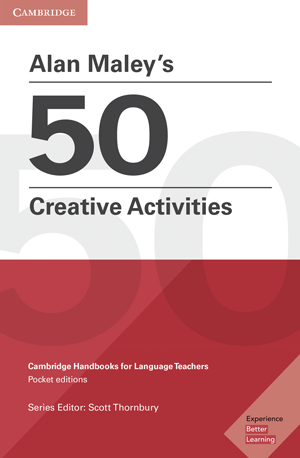Alan Maley’s 50 Creative Activities
Mark Rooney reviews Alan Maley’s 50 Creative Activities.
Alan Maley’s 50 Creative Activities
Alan Maley
Cambridge University Press 2018
ISBN: 978-1-108457-76-7

Teachers are, and I believe should be, creative people. In fact, for many of us creativity is the skill we rely on the most in our teaching careers. We have all experienced those moments of excitement when we suddenly come up with a novel solution to an old problem; when we find new ways of teaching something that has become stale and familiar; when we connect ideas that had been previously unconnected. Yet, for all its practicality, we often think and talk about creativity as if it is something we have no control over; that it is an ‘innate talent’ often borne of ‘inspiration’. When in fact, creativity is a skill, and like all skills, it can be practised and developed. Alan Maley’s 50 Creative Activities aims to help teachers do just that.
Maley’s book is another in the Cambridge pocket Handbooks series from series editor Scott Thornbury. The books are nominally for teachers at all levels of career experience; novices should find plenty that is new, while there may be fresh perspectives for experts to consider. These guides are generally light on theory and heavy on practical activities. They are intended to prompt teachers more to action than reflection. Maley’s edition is no exception, with 50 activities that describe what happens in the classroom more than in the minds of the learners. In fact, apart from a brief introductory essay, the author does little to explain the pedagogical value of each activity. We are left to assume that creativity in the classroom is in and of itself a good thing. Indeed, there are times when reading some of Maley’s descriptions of activities when it is hard to disagree with this assumption. There does seem to be an inherent value in getting learners to approach language in creative, often artistic ways.
The book is divided into five sections, each one dealing with different domains of creativity, namely: creative writing; working with music and sound; working with drama and voice; playing with language; and a brief section of hands-on activities. Each activity is given a brief introduction that offers a way into the task and what follows is generally a procedural description of how to administer the lesson. The written procedures are not intended as strict prescriptions on how things should be done, but more as models to be adapted to your own purposes. In that sense, it is not a pick-up-and-go activity book.
Fittingly, to get the most out of this book a certain amount of creativity will be required of the reader. In fact, as you read the procedure for each activity you are often compelled to stop and consider what adjustments are necessary to ensure success with your learners. This is no bad thing, and is likely Maley’s intention. In my own experience, there were many activities that instantly seemed valuable. With only minor adjustments, I could envision them working well with my learners. Meanwhile, the value of other activities did not instantly reveal itself to me; in fact, some I dismissed as being unfit for my teaching context. However, in the spirit of the book’s theme, I considered how I might apply a little creativity of my own toward adapting these activities. Interestingly, this prompt was enough for me to find something novel and worthwhile in the majority of activities. Often, by the time I finished modifying the activities, they bore little resemblance to what was originally described in the book. This is a testament to what creativity can be. A complex process of interpretation, adaptation and connection.
For novice teachers, it is worth mentioning that many of the activities in this book work best as catalysts for new ideas. Direct adoption of these materials may not go as planned and this might dampen the creative spirit. I suspect that some of the poems, songs and pictures presented as models would not engage all learners; this is a question of age, culture and preferences. After all, when it comes to art, one person’s treasure is often another person’s trash. Therefore, it is worth remembering that when considering how to adapt Maley’s activities for your classroom, you should at least have a sense of your learners’ interests within the artistic spheres. In the end, we want learners to embrace their creative instincts; we do not want teachers indulging their own tastes.
Maley has compiled an interesting list of activities that have the potential to initiate a creative process within both teachers and learners. I am confident that most teachers will get at least a handful of activities from this book. It is possible that some activities will become staples of their teaching repertoire. While others could provide the catalyst to gain new perspectives on their learners, language and the intricate relationship between the two.
Mark Rooney
Mark Rooney is a teacher, teacher-trainer based at Monash University English Language Centre at Monash College in Melbourne, Australia.
Comments
Write a Comment
Comment Submitted